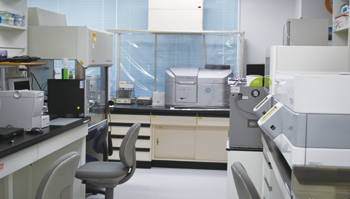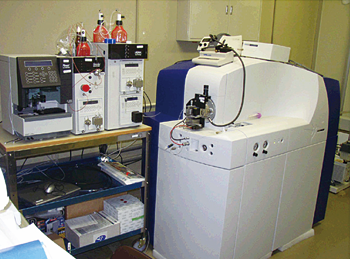Facility Management: The establishment of infectious diseases is driven by the gene expression of pathogenic organisms within the infected host cells. To understand parasite pathogenesis and pathophysiology and to develop new methods to prevent and treat infectious diseases, it is necessary to identify the pathogenic genes that are expressed in the infected host cells and to determine how they induce disease at the genetic level. This process requires an analysis of the transcriptional patterns of both the genes of the pathogenic organism and the responsive genes of the host genome.
The DNA-chip Development Center for Infectious Diseases is a unique facility that was established in 2004 to analyze the transcriptional dynamics and variations involved in infectious diseases. Two research approaches are employed in this facility:
 |
Fig. 1: High-density DNA microarray system. |
 |
Fig. 2: MS/MS spectrometer. |
(1) Transcriptome analysis using DNA-chip analyzers
The high-density DNA microarray system in this facility permits comprehensive transcriptional analysis of gene expression in the human or mouse host, and in various pathogenic organisms. Two DNA microarray systems (Agilent- and Affymetrix-type) are available in this center. Our real-time PCR analysis system (ABI, PRISM7900HT-2) and Nano-counter are useful for more accurate quantitative analysis of the transcriptional levels of particular genes. In addition, a novel DNA microarray system (Genopal of Mitsubishi Rayon Co. Ltd.) is currently being used in this center. An example of its practical use is the establishment of a blood RNA-based system for the diagnosis of autoimmune diseases such as vasculitis. This system employs a “focused microarray” that examines the expression of ~200 blood cell-specific and disease-related genes.
(2) Proteome analysis using mass spectrometry
Comprehensive translational analyses are also very important in furthering our understanding of infectious diseases. The MS/MS spectrometer installed in this facility allows the analysis of the expression, interactions, and modifications of proteins from humans, mice, and pathogenic organisms. This center is also capable of recent technical innovations, such as the mass spectrometric detection of pathogenic organisms to facilitate the development of novel diagnostic systems for infectious diseases.